BEST TOURIST ATTRACTION
TOP 10 TOURIST ATTRACTION
The rugged landscape of the least densely populated country in the world, Mongolia, is the perfect adventure destination for the traveler who seeks a glimpse into a different culture. Here are ten places that you should not miss when you are here:
One of the most popular travel routes in Mongolia is the Gobi desert, the habitat of the rarest animals and a unique natural landscape. The Gobi Desert is a vast zone of desert and desert steppe covering almost 30 percent of the Mongolian territory. The area is often imagined as a lifeless desert like in many other parts of the world. In reality, most part of the Gobi Desert is a land of steppes, sands, mountains and it is the home for camel breeders rich with wildlife and vegetation. Wild asses, camels, snow leopards, mountain sheep and gazelles flourish here, as do different types of flora. Dinosaur skeletons and their petrified eggs have been preserved here to the present day. |  |
Northern Mongolia is a main travel destination of Mongolia. | 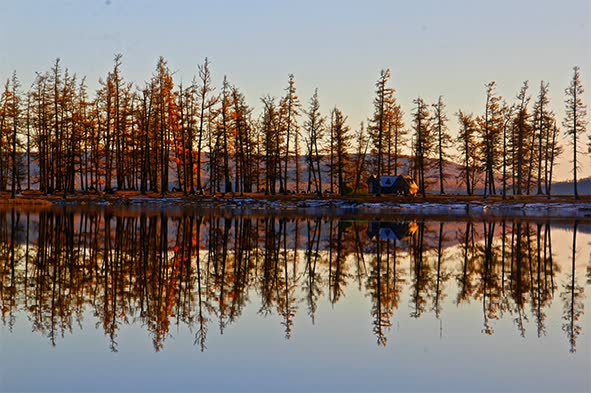 |
Tsagaan suvarga, 90degree of straight, consists of many colors of clay deposits. This is 65 km south west of Ulziit sum, Dundgovi province. Tsagaan suvarga is big escarpment with 200m height and 400m long. In ancient time there was a big sea in a Khevtee and Bosoo valleys of Tsagaan Suvarga. After dried up the sea this area became area with many glacis and escarpments, covered by many different sedimentary deposits. There is a cave with two doors called Khevtee and Bosoo which is home of many bats. | 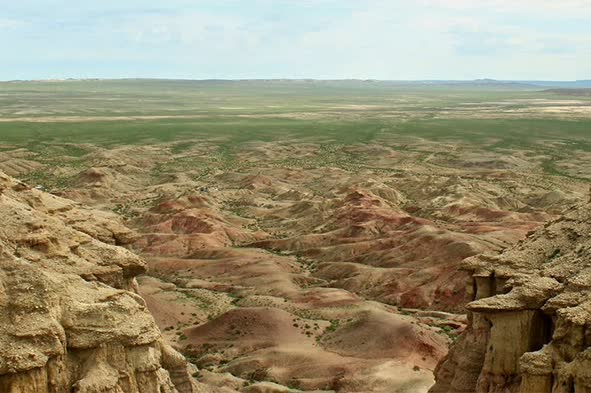 |
Central Mongolia is includes the most visited areas in countryside. This region has many historical sights , natural wonders in Mongolia’s heartland, particularly in the Orkhon River Valley, known as Orkhon Valley Cultural Landscape, which is an encompasses an extensive area of pastureland on both banks of the Orkhon River and includes numerous archaeological remains. It was registered by UNESCO in the World Heritage List as representing evolution of nomadic pastoral traditions spanning more than two millennia. |  |
Ulaanbaatar, the capital of Mongolia established 1639, is the country’s economic, cultural and a political center and has a number of tourist attractions where modern life comfortably blends with Mongolian traditional lifestyle. Wide streets are flocked by modern cars, while horsemen and cattle are still common scene and its population as of 2014 is over 1.3 million. |  |
Gorkhi Terelj National Park is one of the national parks of Mongolia. The Terelj tourist zone has a number of tourist camps (Mongolian: жуулчны бааз, juulchny baaz). It is connected with Ulaanbaatar by a paved road (main road to the East #A0501 Baganuur-Öndörkhaan direction, 37 km from Ulaanbaatar city center, left turn to the branch #A24, 5 km later road crosses Tuul River and the National park territory begins). The road comes to the Gorkhiin Davaa (Mongolian: Горхийн даваа) pass. Most of the tourist camps and tourist attractions are before this pass. The road then ends at the settlement of Terelj, which features small shops and restaurants. The Terelj settlement is located in the valley of the Terelj River (Terelj Gol), approximately 66 km from the Ulaanbaatar city center. The national park tourist zone is formally in Nalaikh düüreg(district) part of Ulaanbaatar municipality, the rest of the protected zone beginning to the north of the Terelj River, is located in Mongolia’s Töv Province | 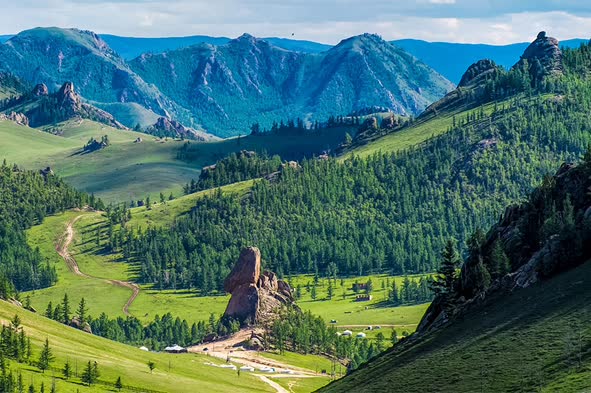 |
ALTAI TAVAN BOGD NATIONAL PARK Altai Tavan Bogd National Park is located on the Western most point of Mongolia in Bayan-Ulgii Province. This vast mountainous park borders China and Russia with views of Kazakhstan from the highest peak in Mongolia.The people living inside the park are one of the main draws. Kazakhs and Tuvan nomadic herders live inside the park and visiting them is part of most tours. The Kazakhs are the most numerous and the ones that do eagle hunting. They are known for their colorful large ger with rich embroidered wall hangings and their warm hospitality. Tuvans occupy the Tsagaan Gol valley and have different clothes, food, and language than Mongols. Tuvan men sing deep eerie long-songs using throat-singing, though very few Tuvans in this isolated pocket have mastered the art. Kazakhs live around the lake, as well as Tsagaan Salaa and Takhiltyn Havtsal (and most of the rest of the park). Those living inside the park have retained their traditional culture to a greater degree than probably any Kazakh in Central Asia. They have preserved their arts and music, and have practiced the ancient sport of eagle hunting continuously throughout the Soviet era when it was suppressed elsewhere. | 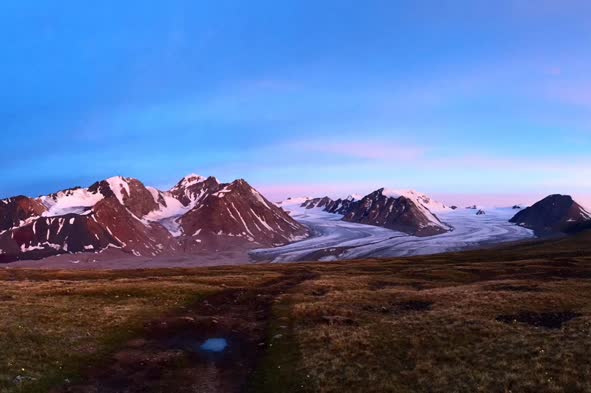 |
In 1580, The Prince Avtai sain Khan and his brother Tumenkhan met with the 3rd Dalai Lama and planned to establish a monastery on the ruins of Karkhorum, and the Tibetan Buddhism was declared religion of state in Mongolia. At its prime time, Erdene Zuu monastery used to be not only the center of Buddhism of Mongolia but also was a centre of intelligence and culture, where sages and academics from different countries used to gather. During the political purge, only three temples and the outer wall with the stupas remained intact. The temples were transformed in museums in 1947. After the fall of communism in 1990, the monastery became a place of worship again, where many pilgrims come to walk and gather their thoughts. Today Erdenezuu Monastery is famous for its ancient temple architecture, unique museum with rare exhibits. It’s certainly the first and oldest Buddhist monastery of Mongolia. Erdene Zuu Khiid is considered by many to be the most important monastery in the country, though no doubt it’s a shadow of what it once was. Not much is left of the fabled city But monastery is still ancient. The local souvenir shopping across from the parking would be interesting and enjoyable. |  |
The Mongolian Government declared Hustai National Park as a Specially Protected Area in 1993, one year after the initiation of the reintroduction of the last species of wild horse project. The Wild horse became extinct in the wild and was last seen in the Gobi in the late 1960s. It survived only in zoos and private parks around the world. The reintroduction program began in 1992. Horses were selected for maximum genetic diversity and gathered at semi-reserves in the Netherlands. Over a two year period, they formed socially normal herds, each consisting of a stallion and his harem of mares. Then they were flown to Mongolia from Luxembourg airport. These shipments (of 16 horses each time) continued every two years until 2002. In addition to the takhi, there are populations of maral (Asiatic red deer), marmots, steppe gazelle, deer, boar, manul (small wild cat), wolves and lynx. The takhi and marmots are easy to see on a game drive in early morning or late afternoon. The other mammal species need some patience and are more likely to be seen while hiking on foot around the reserve. You can go hiking, horseback riding, or take a road trip through Hustai N.P. Seeing these truly wild horses which numbered in the hundreds of thousands of years ago as captured in archeological records, will make you feel like you have traveled thousands of year back in time. | 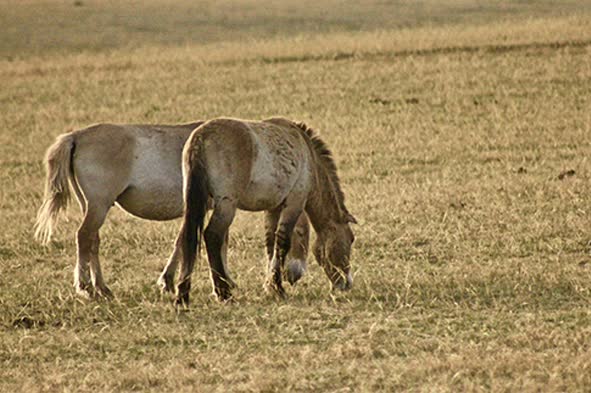 |
KHORGO TERKHIIN TSAGAAN NUUR NATIONAL PARK Khorgo Mountain is a dormant volcano which lies on the east of the Terkhiin Tsagaan Lake. The Khorgo crater, situated at an altitude of 2.210 meters with a diameter of 20 meters and depth of 70 to 80 meters, is the most interesting at all. The Khorgo volcano is covered with basalt. The northern slope is covered with Siberian Larch (Larix sibirica). It has been protected since 1965, fully in 1997, to safeguard spectacular mountain scenery and endangered fauna and flora. There is no lake in this crater, but clouds of steam jet out it is crevices forming ice moulds in winter, which from a distance look like large flocks of sheep scattered on the mountain. Near the crater there are dozens of small caverns with stalactites hanging from their ceiling and walls. About 8000 years ago volcanic lava flooded the valleys nearby which are covered today with small forests of Siberian larch and a great variety of berries and flowers. In the woods there are lots of deer, wild goat and other animals, as well as various kinds of birds such as Red Deer, Siberian Deer, Wild Boar, Ruddy Shelduck and Duck. | 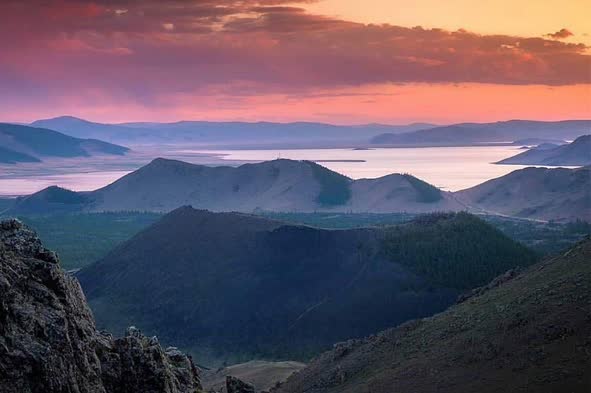 |
RELATED TOURS
Mongolia is rich in culture and traditions. The nomads have roamed the steppes for centuries developing intricate systems for survival in the harsh climate and barren landscape of Central Asia.
A Ger is Mongolian traditional round shaped dwelling that has been used since the Mongols started nomadic life with animal husbandry. Ger is portable, easily assembled and disassembled,
When people think of Mongolia the first images that comes to mind are usually Chinggis Khaan, freezing winters, dry deserts and horses. All of these can be found in Mongolia but there is so much more.


